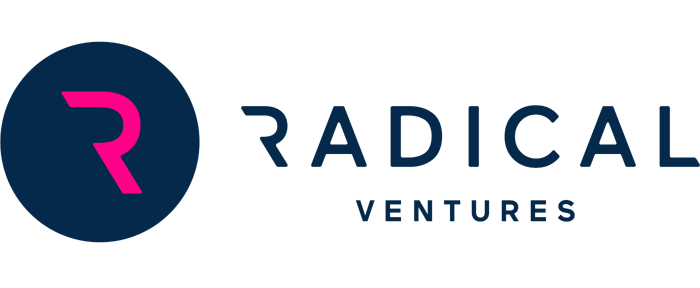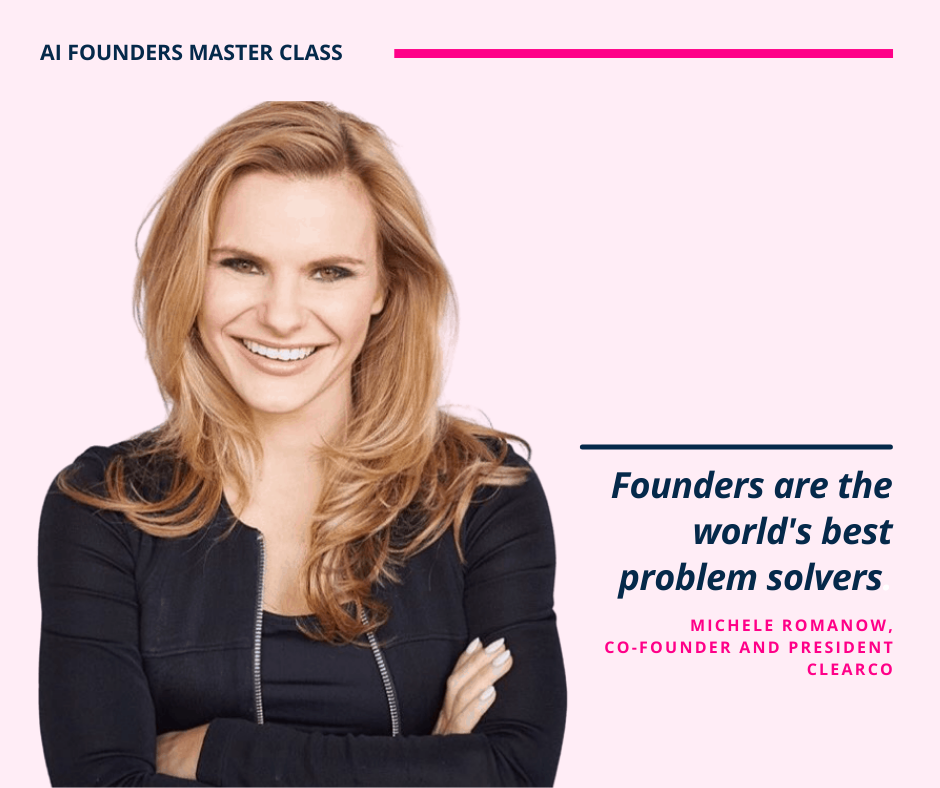This week we bring you part 2 of our conversation with Michele Romanow, featuring the entrepreneur’s perspectives on what it takes to succeed as a founder.
The Clearco (formerly ClearBanc) Co-founder and Dragon’s Den judge spoke with Radical Ventures Co-founder and Partner Jordan Jacobs as part of Radical’s AI Founders Master Class, a four week program aimed at helping AI researchers build AI products and businesses. Over 200 students and faculty from the Vector Institute for Artificial Intelligence, the Alberta Machine Intelligence Institute, Mila (Quebec’s AI Institute), Stanford University, and Oxford University registered to participate in the four week program this fall.
You can read Part 1 of Jordan’s conversation with Michele here. The following excerpt has been edited for length and clarity.
Jordan Jacobs (JJ): In the first AI Founders Master Class session, computer vision pioneer Fei-Fei Li discussed two competing forces that drive founders. On the one hand, there’s grit and that willingness to plow ahead in the face of lots of rejection and difficulty. On the other hand there’s adaptability, knowing when it is time to stop and change course. You have seen this in the companies you invested in, and you’ve experienced it yourself as a founder. Plowing ahead or making a pivot — how do you go about determining the right course of action?
Michele Romanow (MR): It is the hardest thing to know. When you pitch, you pitch the very best version of yourself, and the very best version of your company. But as a founder you need to look at your own data without any gloss on it. You need to sit there with your own data and really understand: are your customers liking your product, and are they coming back? If you are looking at a single stat on anything, it should be retention. Because I genuinely believe anyone will do anything once. Doing something twice is rare. You aren’t doing something twice unless you like it or unless there is some value add. Never mind three or four or eight or nine times.
You and your co-founders intimately know your business, and you are really the only people that are truly capable of making this decision. At Clearco, we had just raised our Series A on a business built around Airbnb. We talked about e-commerce lending in our pitch, but it was 10% of our business at the time. I remember going to an August board meeting with my co-founder after looking at our own data and knowing that we were onto something with this e-commerce thing. And I also knew that the upcoming Black Friday would be our last time in the market where we didn’t have a competitor. So we went to our board and we said “look, we want to pivot the whole company,” which was about 30 people at the time, “to e-commerce. Overnight – we just want it to pivot.” And, Jordan, guess what they said?
JJ: What did they say?
MR: They said, “don’t do it.” Every single one of them said, “don’t do it.” But we pivoted the whole company and changed the entire trajectory of our history. You will not have the backing of the world when you make one of these decisions. You may not have perfect data, but you need to look at your results and then trust your gut.
JJ: When you were building your first startup, the tech ecosystem in Canada was pretty thin. There weren’t very many like-minded people you could go and speak to. But things have changed. There’s now a critical mass of tech founders and, here in Canada, there remains a sense of collegiality among founders who are interested in helping each other out. How important is it to nurture these informal forums to talk through the challenges of being a founder?
MR: My mother was a therapist and she said, “the only difference between the people that come see me, and the people that don’t, are the people that have social circles around them.” You need that circle of other founders. First time founders typically go and get feedback from their smart friends. You ask your smart lawyer friend, your smart doctor friend, your smart accounting friend… and the problem with those people is that they’ll point out all the reasons your business won’t fail. And the worst part of their analysis is they will be correct. But you don’t build a business on minimizing risk, you build a business on betting on a couple big things that completely change your trajectory, like one big hire, one big partnership, one big deal, and that’s really what gets you to escape velocity. And so it’s other founders that can remind you of this. At the end of the day founders actually want to help other founders. If you want to take the risk, they will be the ones cheering you on.
JJ: Any final advice you would give to people who are at the very beginning of their journey as entrepreneurs?
MR: Start now. That’s my one piece of advice. It never feels like you’re ready. It always feels like you’re under prepared. It’s like that moment when you’re looking at the swimming pool and the water is cold, but it’s not getting any warmer and you’re not getting any warmer. You’ve just got to jump in and figure out how to tread water.
I look at all the challenges we face collectively. We need more founders. Founders are the world’s best problem solvers.
AI News This Week
-
DeepMind AI tackles one of chemistry’s most valuable techniques (Nature)
DeepMind has used machine learning to predict the distribution of electrons within a molecule and to calculate its physical properties. Because electrons interact with one another, knowing the physical structure of a molecule and understanding where its electrons are in time and space is a “computational nightmare.” For years researchers — from pharmacologists to battery engineers — have relied on a set of techniques called density functional theory (DFT) to predict molecules’ physical properties. This approach, however, requires supercomputer infrastructure and remains error-prone. The DeepMind team trained an artificial neural network on data from accurate solutions and then tested the trained system on a set of molecules that are often used as a benchmark for DFT. The results were impressive. With the model now trained, individual predictions can be done on a regular laptop, vastly reducing the cost and carbon footprint in this area of material research.
-
AI researchers release toolkit to promote AI that helps to achieve sustainability goals (VentureBeat)
Innovations in AI have shown promise in helping to plug the data gaps when it comes to monitoring the global sustainable development goals (SDGs). Coinciding with the annual NeurIPS research conference, the Stanford Sustainability and Artificial Intelligence Lab released a benchmark dataset called SustainBench for monitoring sustainable development goals (SDGs) including agriculture, health, and education using machine learning. The goals of the dataset include lowering the barriers to entry for researchers to contribute to achieving the SDGs; providing metrics for evaluating SDG-tracking algorithms; and encouraging the development of methods where improved AI model performance facilitates progress towards the SDGs.
-
The therapists using AI to make therapy better (MIT Technology Review)
Ieso, a UK-based mental health clinic, is pioneering a new approach to mental-health care in which the language used in therapy sessions is analyzed by an AI. A natural-language processing (NLP) system is used to identify which parts of a conversation between therapist and client seem to be most effective at treating different disorders. The aim is to give therapists better insight into what they do, helping experienced therapists maintain a high standard of care and helping trainees improve. Facing a global shortfall in care, an automated form of quality control may prove essential in helping clinics meet demand.
-
To see proteins change in quadrillionths of a second, use AI (Wired)
Certain proteins fold or bend after being illuminated, triggering huge changes almost instantly. For example, when a retinal protein in our eyes changes shape, it activates some of our photoreceptor cells. Another important example of proteins interacting with light is in plants during photosynthesis. Details of this important light-induced molecular shape-shifting, called isomerization, have eluded scientists for years. But now a team of researchers have combined machine learning and quantum mechanical calculations to get the most precise record yet of structural changes in a photoactive yellow protein (PYP) that has been excited by light. Their study showed that they were able to make movies of processes that occur in quadrillionths of a second.
-
Semi-automated VAR offside is here, and FIFA thinks it’s going to be transformative (ESPN)
AI will help officiate the 2022 World Cup in Qatar, at least in part. FIFA announced the use of an AI system to assist with determining off-side calls. Using tracking data and sensor technology from camera systems, the AI will create three-dimensional models of a player’s position instantly. Along with automated ball detection, the system identifies the “kick point” and which part of a player’s body is furthest forward. The computations will happen almost instantly, allowing for AI officiating to be seamlessly integrated into the game.
Radical Reads is edited by Ebin Tomy (Analyst, Radical Ventures)

